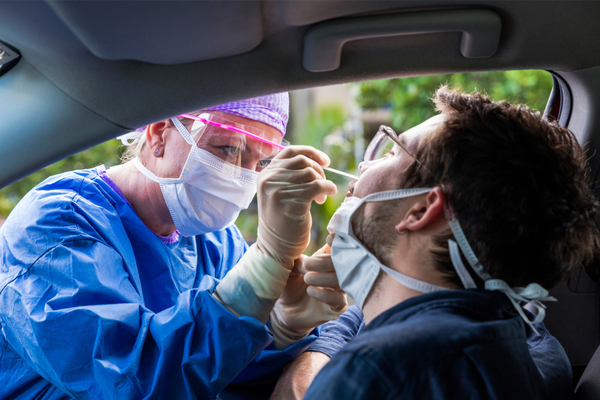Seems like everyone is getting Covid-19 tests (whether they have symptoms or not) before seeing family, to justify traveling, or just to be aware of their status.
It’s easy to understand. People are scared: Forty-eight percent of Americans said they’re anxious about the possibility of getting coronavirus, Covid-19, and even more (62%) said they’re anxious about the possibility of family and loved ones getting coronavirus, according to a poll conducted by the American Psychiatric Association. Routine screening seems to be a way to reassure yourself (and others) that you’re following the rules and, in some cases, that it’s OK if you break them.
But the US is currently in the midst of a third wave of the pandemic; the nation set a new single-day record on October 29 with 83,757 new cases. Considering the fact that the spring saw widespread shortages in testing supplies, could routine testing overtax the medical system? “The availability of testing does seem to have improved,” says Suzanne Pham, MD, medical director of the COVID-19 response team at Weiss Memorial Hospital in Chicago. “Whether or not supplies will last as long as they need to, I do have worries about that.”
Despite steps the US has taken to better prepare itself for another onslaught of cases, hospitals, labs, and medical centers are still not at a point where they can handle unlimited testing. “If someone’s at an increased risk for severe illness or has close contact with someone who’s at an increased risk for severe illness, I think getting tested regularly is smart,” says Dr. Pham. “For those who are merely worried but don’t have a history of contact with anyone of concern and aren’t at an increased risk of severe illness, regular testing could strain the system and may take away the ability to test those who truly need it.”
Even though there have been significant improvements in testing, it’s not a perfect screening method, either. Rapid tests, which are becoming more widely available, use the same technology as polymerase chain reaction (PCR) tests, which directly detect the presence of an antigen, something that induces an immune response, rather than the presence of the antibodies.
Rapid tests, however, aren’t quite as sensitive as the PCR tests, so they may not detect the virus at a lower load. “The benefit of a rapid test is, if you’re positive, you know pretty quickly,” says Dr. Pham. “The downside of a rapid test, is if you’re negative, you don’t know for sure if you’re truly negative.”
So much depends on the timing of your test, Dr. Pham adds, because it takes a certain amount of time for the virus to replicate enough to even be detected. “If you were exposed an hour prior to getting tested, well, it’s highly unlikely that test is going to pick it up. It may take three, four, or five days for you to test positive,” she explains—and, during all that time, you could be infecting others.
That’s not to say doctors—including Dr. Pham—aren’t all for more testing. “You can’t manage what you can’t measure, and we need massive, full-scale development and deployment of COVID-19 testing,” Joseph Allen, director of the Healthy Buildings program at Harvard, an assistant professor of Exposure Assessment Science at the T.H. Chan School of Public Health, and a member of theLancet COVID-19 Commission, said in an interview with Health. In an ideal scenario, routine testing could not only catch potentially asymptomatic cases, it could also catch cases before symptoms develop, helping to slow the spread.
Eventually, testing will be normalized, and getting a COVID-19 test may be as simple as, say, getting a pregnancy test. “The accuracy of these tests is getting better each week, and the arrival of low-cost, antigen-based rapid tests that you can self-administer and get results from within minutes could fundamentally shift the course of the pandemic,” says Allen. But the rollout of those tests takes time. Abbott Laboratories, for example, is shipping 100 million rapid COVID-19 tests for free. “That sounds like a lot, but it only means every third person in the country gets a test once a year,” says Allen. “We need a massive upscaling.”
Even then, the problem with casual testing comes when people rely solely on it. “We have evidence of that in a high-profile, spectacular way at the White House,” says Allen. “They had a testing-only strategy and ignored all other controls—no social distance, no mask-wearing—so it was never a question of if infection would happen at the White House, it was just a matter of when.”
Regular testing is only a part of COVID-19 prevention. “We still have to do everything else: Maintain a small social network, stay socially distanced, wear masks, and wash our hands,” says Allen. “When testing is done right, with those controls in place, it can work really well. Just look at the major sports leagues.”
The NBA, which resumed its season in July, reported no COVID-19 cases during the 90-plus days players, coaches, and staffers were sequestered in a protective “bubble” in Florida to reduce exposure risk. Everyone received COVID-19 tests at least every other day for the week before joining the bubble; after that, players who left the bubble were required to be tested each day they were gone if they left for less than a week, or at least the seven days before returning to the bubble if gone longer.
But if you’re not getting tested regularly, that’s OK. The Centers for Disease Control and Prevention (CDC) still maintains that not everyone needs to be tested. Those who should get tested, they say, are people who have symptoms of COVID-19 or people who have had close contact (within 6 feet for a total of 15 minutes or more) with someone with confirmed COVID-19. As long as you follow those safety guidelines, there’s no need to get tested weekly. “We know these other control strategies work,“ says Allen. “It’s about sticking to the basics.”
—
Photo Credit: zstock / Shutterstock.com
